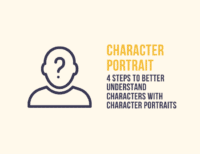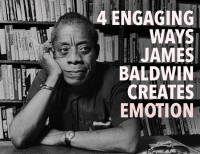A couple of months ago I attended a reading and book signing with Terry McMillan, the best selling author of Waiting to Exhale. She discussed her upcoming book, Who Asked You?, which contains fifteen different points of view, including one of an eight-year-old boy. With that many POVs, there was no way ALL the characters could be autobiographical, so during the question and answer period I asked her—how did she get in the minds of characters so unlike herself?
Her answer can be boiled down to the following: you must (1) empathize, (2) listen to those around you, and (3) fill out a job application on behalf of your character.
Photo by Thomas Leuthard
Empathize
To write in the mind of a rich nine-year-old boy when you are a working-class thirty-year-old woman, you need a certain degree of empathy.
What would a young boy spend his days thinking about? What would cause him to worry? How much knowledge would he have about the people and things with which he interacts?
You don’t need to know what his experience is like if you allow yourself to literally imagine how it feels to walk in his shoes (and sleep in his bed and eat his breakfast and watch his TV shows).
Listen
How can a twenty-something white man write dialogue for an elderly Chinese woman? Simple. By listening.
Pay close attention to the people around you at your job, on the train or in the supermarket. When you find someone in your character’s demographic, listen to how he or she speaks. Notice to whom that person is talking (does the speech change when she speaks to someone else?).
Then use what you have heard in your writing.
Fill Out a Job Application on Behalf of Your Character
Terry McMillan said she knows everything about her characters before she starts writing. It began when she grabbed a job application from a local establishment and then filled out on behalf of her characters—full name, date of birth, work experience, strengths and weakness.
Over time she added more and more questions to the list—does the character pay her taxes on time? Does she believe in abortion?
Only a small portion of these details ever made into her novels, but she knew everything she possibly could about the characters she created.
By answering these basic questions on behalf of your characters, you will develop a clearer idea about who they are as people before you start writing. They may be nothing like you, but after engaging in this practice you will at least know who they are.
Ask yourself, what is your character’s worst childhood memory? What is her favorite movie? Did she ever have a bad break up?
Are any of your characters completely unlike you?
PRACTICE
Find a job application online or elsewhere. Complete it for one of your characters.
Or, go to a public place and identify a person with whom you think you have little or nothing in common. If you want, listen to how they are speaking and what they are speaking about. Spend fifteen minutes writing about that person’s day from his or her point of view.








I love the idea of filling out a job application on behalf of my characters. It also will help me keep track of them and maybe one of them will get a job while I wait for the royalties to pour in!
Haha! I think engaging in those types of exercises just make the characters more real in your head, you know?
Great post, Monica. This model would work great for any type of character. It also belies the age-old argument that you can only write what you know. If that were the case, you would have one character only (that closely resembled you), a limited choice of settings, and (most likely) pretty boring plot lines.
Using these three techniques, any writer could expand their repertoire. Thanks for such good ideas – bookmarked!
Thanks Rhonda! I think it’s fun to write about people and situations that are new to you–it forces you to be creative! 🙂
Great advice Monica! I’m really happy with a couple of characters in my novel, a few I’m mostly satisfied with, a couple feel flat and I can’t get them to come to life. After reading your post I realize those characters are the ones I don’t know much about. Time to get to know my characters!
Good luck! Let me know how it goes. 🙂
I’ve only recently heard the idea of filling out a job application for characters. I really like that idea – especially for the characters that are harder to get to know. Thanks!
I’ve also been taught to fill at least two pages with the main characters’ autobiographical details before I start. I think filling in a job application is an interesting exercise, because each one then describes his self-image, the person he thinks he is!
Some people say the less details you decide on before you start the story the less you limit your options you may need later to make that character ‘fit’. Perhaps the answer is that nothing is etched in stone and can be changed when the need arises.
Yeah different strategies work for different people, but for me, the more I knew about my plot and characters the better. It’s nice to have something to refer to when you feel like you’re getting off track.
Very timely post!
I have character sheets, but have largely ignored them for my current WIP, thinking, “I’ll get in touch with characters as I go.” But one main character has eluded me….like completely :/
Seeing this post, I’ve been filling out a sheet and it’s helping 🙂 I would post it, but it spoils a lot (a lot!!). So I’ll just have to announce the finished product and thank you then 🙂
I’m so glad this helped!!
Doing what you say, is not easy but if you put all your heart and your focus on that you can complete and do well.
I agree–not easy!! But we’re not in this because it’s easy are we? 🙂
Enjoyed this post! I’ve used the character sketches from NaNoMo’s book for my last book and it helped tremendously to ‘know’ so many fine details about the characters.
Yes, it has helped me a lot too. I need to do it more with my more minor characters.
I write interview-based non-fiction but when I had to do a creative assignment for a Media/Comm class, I followed the instructions – and ended up with one of the best writing experiences I’ve ever had. I’ll leave out the steps for how to choose your person:
– select a significant event in your character’s life
– identify the year, month, day
– if it’s close to a public/community episode or is otherwise newsworthy, do a little research into that event
– if it’s personal/family, do a little research into similar psychological situations
– describe how did this impacted your character’s life by writing a letter to someone in that character’s life
– could be to a public figure, friend, family, anyone but letter must be important – not hi, how are you, just catching up
– write it in first person – get the rhythm of the person’s speech pattern, odd turns of phrase, misspellings
– and write it by the same means the character would have had available – is this in 1950? handwrite it or type (yes, on a typewriter)
Sounds a little crazy, I know. But it’s very close to filling out the job application, described in the post here.
I ended up researching for about 8 or 9 days, circling key items on the printout of my notes, then sitting down to write – it wasn’t quite channeling, but I was definitely in the zone! I wrote as someone outside my gender, race, geographical place of growing up, class and culture – and it’s among the most alive pieces of writing I ever did. Now adapting that technique as I write the text of my next NF book…
Thank you for a great tip